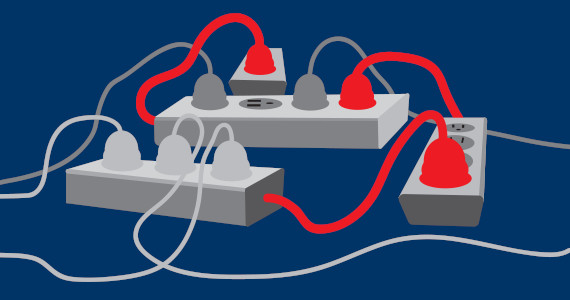Not Safe: Daisy Chaining Power Strips

Power strips are widely used in households and offices. Much of the time they are used because there are not enough outlets to meet the electrical demand. The proper use of a power strip usually does not cause a hazard. It’s the improper use that can cause safety issues, such as creating a potential electrical failure and/or a possible fire hazard. An example of using power strips unsafely is when they are “daisy chained” together.
Definitions
Power Strip
A power strip is used to provide multiples sources of power (outlets) in an application with limited outlet access. It can meet electrical power requirements with minimal connections. In UL 1363, it is called a RPT (Relocatable Power Tap).
Daisy Chaining
This is a term that refers to power strips and/or extension cords being plugged into other power strips and/or extension cords. Daisy chaining usually occurs when there are not enough established outlets to meet electrical needs.
Safety Codes and Regulations
The main problem with daisy chaining is that it is against many safety codes and standards—including OSHA (Occupational Safety and Health Administration), the NFPA (National Fire Protection Association), and UL (Underwriters Laboratories).
OSHA Standard 29 CFR 1910.303(b)(2)
Installation and use. Listed or labeled equipment shall be installed and used in accordance with any instructions included in the listing or labeling.
OSHA Standard Interpretation
In an OSHA interpretation regarding power strips, an OSHA Director, Richard Fairfax, included this statement: “Manufacturers and nationally recognized testing laboratories determine the proper uses for power strips. For example, the UL Directory contains instructions that require UL-listed RPTs to be directly connected to a permanently installed branch circuit receptacle; they are not to be series-connected to other RPTs or connected to extension cords.”
NFPA 1 Standard 11.1.4
11.1.4.1
Relocatable power taps shall be of the polarized or grounded type with overcurrent protection and shall be listed.
11.1.4.2
The relocatable power taps shall be directly connected to a permanently installed receptacle.
11.1.4.3
Relocatable power tap cords shall not extend through walls, ceilings, or floors; under doors or floor coverings; or be subject to environmental or physical damage.
UL 1363 1.7
A cord-connected RPT is not intended to be connected to another cord-connected RPT.
UL White Book (2015-2016)
The UL White Book states this: “Relocatable power taps are intended to be directly connected to a permanently installed branch-circuit receptacle outlet. Relocatable power taps are not intended to be series connected (daisy chained) to other relocatable power taps or to extension cords.”
The Office of Compliance from the United States Government has issued a “Fast Facts” document titled Power Strips and Dangerous Daisy Chains. Regarding problems with daisy chaining, this statement is made: “Most power strips or surge protectors are approved for providing power to a maximum of four or six individual items. When multiple power strips are interconnected, the one directly connected to the building wall outlet is often supplying power to far more outlets than the approved number. This electrical current overload can result in a fire or can cause a circuit breaker to trip, de-energizing computers and other equipment throughout the area that are connected to a surge protector.”
A power strip needs to be connected directly to an outlet that is permanently installed. The power strip should be approved by an OSHA Nationally Recognized Testing Laboratory and it needs to be used according to instructions listed by the manufacturer.
Another key point to consider is that “outlet devices shall have an ampere rating not less than the load to be served.” [OSHA 29 CFR 1910.304(b)(4)] Overloading a power strip is not safe—potential excess heat can create a fire risk.
Extension Cords
A fire hazard may result if an extension cord is overloaded or improperly used. It is against OSHA regulations which state equipment needs to be approved by a nationally recognized testing laboratory. [OSHA 29 CFR 1910.303(a)] It should also be noted that even extension cords that are approved are only for temporary wiring. They are not supposed to be used in a permanent capacity. Consideration needs to be given to the type of extension cord as well. Light-duty cords should not be used for supplying power to a number of items at once—especially those which are considered high energy.
Alternatives to Daisy Chaining
The Office of Compliance gave several safe solutions in place of daisy chaining power strips and extension cords. These included:
- Replace a power strip with a power cord of adequate length to reach an outlet.
- Move equipment or desks or whatever needs electrical power closer to existing outlets.
- Choose the appropriate kind of power strip that will meet the electrical power needs.
- If possible and feasible, add more outlets to meet the electrical power needs.
Emphasis on Safety
The emphasis needs to be on safety when using a power strip and/or an extension cord. Follow the intended use per the manufacturer’s instructions. Follow all safety codes, regulations, and standards according to OSHA, NFPA, and UL. Remember that daisy chaining power strips together is not safe for many reasons. Find safe alternatives instead.
Additional Resources
Interpower offers free technical support. For further assistance, please see Interpower’s contact information below.
Sources:
U.S. Department of Labor OSHA
(www.osha.gov)
OSHA Standard Interpretation
(https://www.osha.gov/pls/oshaweb/owadisp.show_document?p_table=INTERPRETATIONS&p_id=24631)
OSHA Training
(http://www.oshatraining.com/Violations-OSHA-Electrical-Standards-Power-Strips.php)
NFPA 1 Standard
(https://community.nfpa.org/community/nfpa-today/blog/2016/07/22/nfpa-1-electrical-fire-safety-and-relocatable-power-taps-power-strips-firecodefridays)
UL 1363 Standard
2015-16 Guide Information for Electrical Equipment—The UL White Book [p569]
(http://www.ul.com/wp-content/uploads/2014/09/UL-White-Book.pdf?utm_source=multiple&utm_medium=vanity&utm_campaign=codeauthoritieswhitebook)
Office of Compliance – U.S. Congress
(www.compliance.gov)
Fast Facts – Power Strips and Dangerous Daisy Chains
(http://www.compliance.gov/sites/default/files/Fast%20Facts-Power%20Strips%20sept.%202016.pdf)
Fast Facts – Temporary Extension Cords and Power Connectors Should Not Be Used for Permanent Wiring
(http://www.compliance.gov/sites/default/files/wp-content/uploads/2010/08/Temorary-Extension-Cords-Fast-Fact-January-2010.pdf)





